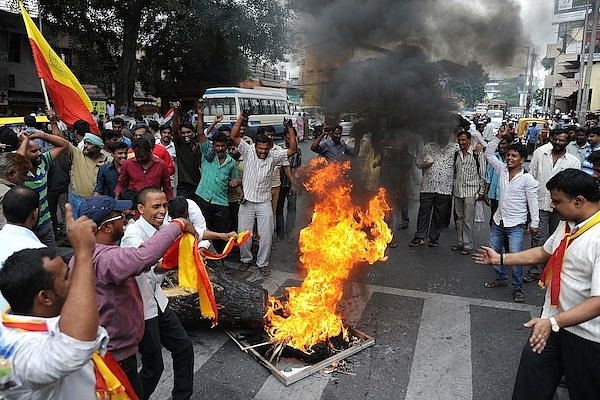Politics
Cauvery On Fire: Only Way To Douse It Is By Revisiting The Basis Of Past Accords
- The Cauvery dispute cannot be solved by adopting a static approach, based on past legal decisions, or a fixed formula for divvying up the available water.
- The focus has to be on augmenting water, and generating a bigger splash for available water though more efficient utilisation of every drop.

Photo: STRINGER/AFP/Getty Images
Politicians don’t usually seek solutions to problems; they try to see how they can benefit from them by polarising voters. This, unfortunately, is the case with the sharing of Cauvery waters, a problem that is nowhere near solution despite festering for over 125 years. Neither Tamil Nadu nor Karnataka did much to prevent the violence against Kannadiga and Tamil properties or avoid the inconvenience caused to innocents caught in-between. The situation in Karnataka has been worse, with several days lost to bandhs, and property worth crores (especially buses) destroyed.
What this shows is an abysmal lack ofpolitical foresight and leadership, with both states allowing the situation to go out of control by letting mobs take over the streets and threatening ordinary people trying to go about their daily work. That there was a bit less violence on the Tamil Nadu side does not mean that state handled the emotions of mobs any better. It was just more fortunate.
The failure of leadership is apparent from the fact that both the Tamil Nadu and Karnataka Chief Ministers wrote letters to each other rather than speak to one another. If Chief Ministers of two neighbouring states cannot pick up the phone and talk to each other even when their streets are on fire, it speaks of leadership failure. Leadership is about showing courage in difficult situations and a willingness to take the right decisions, not about finding out which way the mob is running and then run ahead of it.
The truth is the Cauvery dispute cannot be solved by mobs or even politicians who are too scared to lead, and whose time horizon is limited to the next election. Nor can it solved only through the legal route, for demographics and usage patterns can change over generations. Several attempts, through tribunals, fact-finding committees and political accords, have been tried but the Cauvery problem refuses to go away—especially when monsoons fail in the upper reaches of the Cauvery in Karnataka.As is the case today.
Karnataka was deeply aggrieved when Tamil Nadu got the Supreme Court to release 15,000 cusecs of water a day for 10 days; the state government did not implement the order fully, and the court— despite expressing its displeasure about this—changed its order to 12,000 cusecs a day until 20 September.
While the short-term issue is the sharing of shortage when water is scarce, the long-term solution cannot just be about sharing the water as decided by the Cauvery Water Tribunal’s verdict in 2007.Under this verdict, Tamil Nadu gets around 58 percent of the water and Karnataka 37 percent, with Kerala and Pondicherry getting the balance.
The short point is this: Karnataka has a case for more water, and Tamil Nadu has a stronger legal claim to the water; the solution can be found only when the legalities are set aside and the focus shifts from sharing shortage to creating adequacy of water supplies for both states.
Creating adequate water to meet the genuine needs of both states involves tackling both the demand and supply sides simultaneously.
The demand side involves the following:
One, more water should be made available to either state only if there is a commitment to reduce per hectare usage over time. Technology and farming techniques are the key factor here.
Two, both states have to commit to taking all measures to prevent water wastage, whether through evaporation or seepage in leaky canals. Or plain stealing.
Three, water usage has to be charged— even if this charge is recovered from state budgets rather than users.
Four, a shift in cropping patterns away from high water using crops to others also has to be a part of the shift.
The supply side involves augmentation of water storage and other facilities, including linking some of the rivers in the north to rivers in the south. This will take time, but needs to be done in an ecologically sustainable way.
The bottomline is this: the Cauvery dispute cannot be solved by adopting a static approach, based on past legal decisions, or a fixed formula for divvying up the available water. The focus has to be on augmenting water, and generating a bigger splash for available water though more efficient utilisation of every drop.
Burning buses will not help, but there is little doubt that past agreements on the Cauvery have to be revisited.
Introducing ElectionsHQ + 50 Ground Reports Project
The 2024 elections might seem easy to guess, but there are some important questions that shouldn't be missed.
Do freebies still sway voters? Do people prioritise infrastructure when voting? How will Punjab vote?
The answers to these questions provide great insights into where we, as a country, are headed in the years to come.
Swarajya is starting a project with an aim to do 50 solid ground stories and a smart commentary service on WhatsApp, a one-of-a-kind. We'd love your support during this election season.
Click below to contribute.
Latest